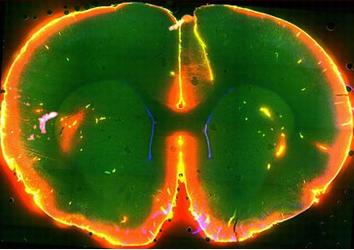
ROCHESTER, New York, October 18, 2013 (ENS) – Sleep clears the brain of toxins that have accumulated in the body during waking hours, American scientists have demonstrated for the first time. The results suggest a new role for sleep in health and disease.
Using mice, researchers showed that the space between brain cells can increase during sleep, allowing the brain to flush out damaging molecules associated with neurodegeneration such as Alzheimer’s disease that build up during waking hours.

The study was funded by the National Institute of Neurological Disorders and Stroke, or NINDS, which is part of the National Institutes of Health.
“Sleep changes the cellular structure of the brain. It appears to be a completely different state,” said Maiken Nedergaard, MD, DMSc, co-director of the Center for Translational Neuromedicine at the University of Rochester Medical Center in New York, and a leader of the study.
“We need sleep. It cleans up the brain,” said Dr. Nedergaard.
The results of this research, published in the current issue of the journal “Science,” show that during sleep a system called the glymphatic system may open, letting fluid flow rapidly through the brain.
Dr. Nedergaard’s lab recently discovered the glymphatic system helps control the flow of cerebrospinal fluid, a clear liquid surrounding the brain and spinal cord.
“It’s as if Dr. Nedergaard and her colleagues have uncovered a network of hidden caves and these exciting results highlight the potential importance of the network in normal brain function,” said Roderick Corriveau, PhD, a program director at NINDS.
Initially the researchers studied the system by injecting dye into the cerebrospinal fluid of mice and watching it flow through their brains while simultaneously monitoring electrical brain activity.
The dye flowed rapidly when the mice were unconscious, either asleep or anesthetized. In contrast, the dye barely flowed when the same mice were awake.
“We were surprised by how little flow there was into the brain when the mice were awake,” said Dr. Nedergaard. “It suggested that the space between brain cells changed greatly between conscious and unconscious states.”
To test this idea, the researchers inserted electrodes into the brain to directly measure the space between brain cells. They found that the space inside the brains increased by 60 percent when the mice were asleep or anesthetized.
“These are some dramatic changes in extracellular space,” said Charles Nicholson, PhD, a professor at New York University’s Langone Medical Center and an expert in measuring the dynamics of brain fluid flow and how it influences nerve cell communication.
Certain brain cells, called glia, control flow through the glymphatic system by shrinking or swelling. Noradrenaline is an arousing hormone that is also known to control cell volume.
Similar to using anesthesia, treating awake mice with drugs that block noradrenaline induced unconsciousness and increased brain fluid flow and the space between cells, further supporting the link between the glymphatic system and consciousness.
Previous studies suggest that toxic molecules involved in neurodegenerative disorders such as Alzheimer’s disease accumulate in the space between brain cells.
In this study, the researchers tested whether the glymphatic system controls this by injecting mice with labeled beta-amyloid, a protein associated with Alzheimer’s disease, and measuring how long it lasted in their brains when they were asleep or awake.
Beta-amyloid disappeared faster in mice brains when the mice were asleep, suggesting sleep normally clears toxic molecules from the brain.
“These results may have broad implications for multiple neurological disorders,” said Jim Koenig, PhD, a program director at NINDS. “This means the cells regulating the glymphatic system may be new targets for treating a range of disorders.”
Copyright Environment News Service (ENS) 2013. All rights reserved.
© 2013, Environment News Service. All rights reserved. Content may be quoted only with proper attribution and a direct link to the original article. Full reproduction is prohibited.
